By Bert Wank, CEO and Founder, infiniRel Corp., Frisco, Texas
Performance monitoring is the key to predicting electrolytic capacitor failures, the biggest problem in keeping solar power inverters on the grid.
Condition-Based Maintenance (CBM) has been used successfully for many years in the mechanical industry to ensure maximum uptime for industrial automation equipment. Mission-critical components and systems such as cooling pumps, hydraulic motor drives, and aircraft cannot tolerate certain errors because they can destroy expensive assets and cost human lives. Historically, preventative maintenance personnel have detected unexpected problems by periodically monitoring wear-out indicators and replacing consumables that routinely handle heat, such as fluids, lubricants, brushes for motors, and bearings.

A global SmartGrid that includes Condition Maintenance aspects would benefit multiple stakeholders.
Because workers must do the maintenance, Western countries have incurred substantial labor costs. And when no consequences arise out of a lack of maintenance, little incentive is given to look ahead. However, in mission-critical applications, affordable, smart electronic measurement systems during the past two decades have supported effective preventative maintenance results, based on the actual condition of the equipment. By addressing cause and effect in a feedback loop for an entire system, substantial expenses have been reduced for operating complex machinery, which measurably preserves operating assets and avoids lost equipment.
Negligence, on the other hand has caused losses in plants and marine and human life, such as seen in deep-water, oil-drilling platforms and oil and gas pipelines. But, traditionally, CBM had been limited to mechanical systems and fluids: Only within the past decade has it included electro-mechanical systems such as disk drives and transformers. The increasing adoption of power electronics in mechanical systems has led to greater control of performance and less mechanical wear and tear, which, in turn, has led to the perception of a more reliable solution – no more moving parts.
But with the rapid growth of the renewable energy market at the same time, electronics has become the Achilles heel of modern power generation and conversion. For example, in a 2008 report, Sandia National Laboratories stated that 59% of all unexpected maintenance costs are due to photovoltaic inverter failures. Half of the plant’s operating cost was unexpected. That is a problem. At unprecedented levels, electronics is now actively managing the energy conversion process, which consists of many 100’s of kilowatts and Megawatts – enough to power about two hundred homes. However, the lack of adequate monitoring equipment to alert maintenance teams before an impending failure has exposed the renewable energy industry to a high degree of long-term uncertainty with respect to up-time and operations cost. Now, performance monitoring in power electronics is limited to failure reporting after the fact, and evaluation of converter efficiency by itself is insufficient to alert operators in time.
Also, the condition is not independently evaluated, because monitors rely on custom read-outs from the manufacturer’s error handling equipment. The manufacturer appears to use numerous sensors within the system, but it is limited in processing power, cost, and complexity, and the flood of data-handling within a system, hampers the management of data traffic through the limited bandwidth of wireless mesh and cellular networks.
The SmartGrid
The SmartGrid is still limited in scope to 15-minute interval readings of energy use and Time-of-Use tariffs, which require magnitudes lower bandwidth than high-performance Condition Maintenance monitors. In its infancy, Smartgrid supporters formed special interest groups, such as SGIP, GridWise, and the SunSpec alliance, but the focus is mostly limited from the meter to the utility. But, there is more than Automated Meter Reading (AMR) applications to justify a SmartGrid: A growing number of stakeholders is vitally interested in providing higher reliability at lower cost. We all can benefit from a continued adoption of renewable energy in our energy mix at more competitive prices and without subsidies. These include utilities, energy service providers, power equipment OEMs, insurance providers, and project underwriters that worry about the project Return On Investment. A contractual period can be as low as 15 years, but it also can be as long as 30 years. Managing risk during such an extended period of liability exposure requires a smart and adaptive solution.

Our research laboratories have developed self-healing networks, distributed-computing architectures, and selflearning, adaptive controls. We can bring those competencies together, and create a power grid that is not only smart, but also connects globally to harness the flow of energy and data for higher reliability, cost-effective maintenance, and eliminate unnecessary service calls.
Are we about to repeat the same mistake our forefathers made by laying down a power infrastructure that severely hampers adding more power to satisfy our ever-growing needs? Although it has been comparatively easy to improve local computing architecture and scale the ever-growing data needs to “cloud computing,” revamping a multibillion-dollar infrastructure that connects America’s homes with the electricity to charge future electric vehicles is taxing. For a cost-effective implementation, we must address scalability from the outset.
The SmartGrid can support Condition-Based Maintenance most effectively when it is setup with a scalable mindset. Instead of preventive maintenance, smart maintenance assesses risk of failure, which costs the renewable energy industry one billion dollars per year.
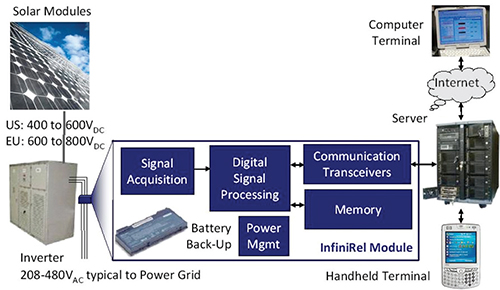
In the future, we may have systems that respond with active intervention into power system operation, which can extend a component’s life until a replacement unit has been brought on site. This lowers the cost of reverse logistic and places cost control back into the hands of operators.
Figure: Smart Sensor Blocks For Condition-Based Maintenance
One of the most fundamental components of power converters is its capacitors. As an example for condition-maintenance, advanced signal processors can analyze how internal components degrade and when they might fail, so that cost-effective, preventative maintenance replaces emergency service calls.

Data management becomes crucial to scalability, and today, we have technologies at our disposal that can address the knowledge supply chain of energy.
It helps maintenance crews schedule replacement parts that are shipped at much lower cost and attend to the equipment at risk with minimal incremental cost, so that consumers can eventually afford renewable energy. This ultimately leads to an accelerated adoption of renewable energy as a viable addition to the existing energy mix. In one example, newer technology wind turbines have adopted direct drive generators, which couple a permanent magnet motor directly to the rotor. Between 2008 and 2009, the global adoption rate has increased from 11.9% to 13.9% in just one year. By eliminating the mechanical gear box, two inverters are being used: the resulting alternating output current (ac) at varying frequencies, and depending on the wind speed, is rectified to direct current (dc). In some instances, dc stored in a battery is then inverted to a 50 Hz or 60 Hz waveform, which is connected to the low-voltage power grid. At least two power converters are involved. Lead indicators of failure are obstructed by a potentially large number of interconnected, distributed-power generation plants, which present a superimposed image of small, high-frequency signals combined with a low-frequency 50/60Hz power grid.
In addition, the amplitude of the signals of interest are many magnitudes smaller than the 50 or
60 Hz signals produced by each inverter, which are typically connected to a 3-phase 208 V, 240 V, 480 V, or 690 V power grid. Also, all three phases are internally connected to the same energy storage element, defined as the “dc-link” capacitor, which effectively couples a string of solar panels to the inverter and “stiffens” its dc supply. A high-performance data acquisition system that uses advanced signal processors and a scalable Sensor Operating System detects and notifies operators of possible failures. A well thought-out, scripted Operating System manages data flow (regardless of the current communications infrastructure) to retrieve threatening alerts.

No clear standard has yet emerged to simultaneously address the data transportation needs of numerous stakeholders in the energy industry.
Electrolytic capacitors are well known to have been widely used for cost-efficient dc-link capacitors, and one of the highest risk components in power converters. In June 2010, Dell reported a $100 million reserve due to power supplies in servers that failed after a number of years in operation because electrolytic capacitors lost electrolyte. In fact, electrolytic capacitors have been widely use with most power converters for decades, and are considered one of the fundamental building blocks for energy storage. But due to their high relative cost, only few applications could afford superior, alternative types, such as film capacitors, which inherently do not use the electrolyte that seeps out during many years of temperature cycling. The Equivalent Series Resistance (ESR) characteristic of an electrolytic capacitor changes with temperature cycling and time, and can be used as a mechanism to indicate a major failure. The capacitor’s degradation causes undue stress for the power stage, and can disrupt service rapidly.
Depending on the application, power converter failure significantly damages the power unit, jeopardizes grid reliability, and can be potentially life-threatening in electric vehicles or avionics. Furthermore, the emergency response for reinstating lost power production increases operational costs because of the unscheduled maintenance needed. A system that is able to predict an impending power electronics failure in-situ would mitigate risk and uncertainty with long-term operation of the power plant, and reduce significant costs and liabilities for the operator.
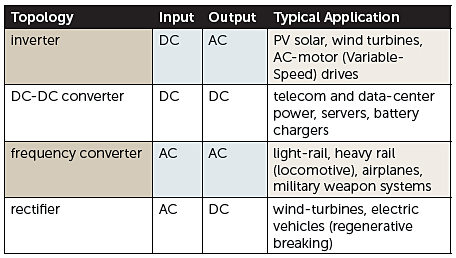
Four Ways of power conversion and their clean energy applications
Previous attempts to overcome these issues have been limited to failure reporting and diagnostics after the event occurred, as opposed to prognostics. Other solutions have relied on computer-based systems to model, simulate, or mathematically calculate a Mean-Time Between Failures (MTBF). None of the concurrent solutions have been able to effectively determine accurately enough the remaining service life of the asset to effectively schedule preventative maintenance. Due to the large variation in operating conditions, such as temperature profiles, electrical load, and component quality, theoretical estimates are too inaccurate and lead to excessive maintenance costs while not addressing the core issue of unexpected equipment failure. A deviation from the traditional modeling approach applies the principals of Failure-Mode and Effect Analysis (FMEA). Because the capacitor is critically connecting other power components within the converter, it is also a harbinger for additional system weaknesses. Thus, the scope of the analysis of capacitor health can be expanded to complementary electronic components, such as semiconductor power switching devices and inductors used as common building blocks for power conversion equipment. A fundamental approach to identifying additional signatures for power electronics failure of switch-mode power supplies in general has been developed. In order to allow rapid adoption, however, the design needs to be independent of power supply manufacturer and component manufacturer, and apply to the majority of switching power supply architectures. Fortunately, there are only four ways, power can be converted:
• Inverters that use a dc input and provide an ac output,
• Dc to dc converters that use a dc input and provide a dc output,
• Frequency converters that use ac input and provide an ac output, and
• Rectifiers that use an ac input and provide a dc output.
infiniRel
www.infinirel.com
::Design World::
Filed Under: Green engineering • renewable energy • sustainability, Energy management + harvesting, ELECTRONICS • ELECTRICAL


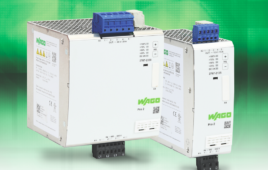

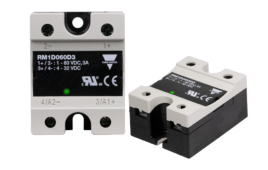
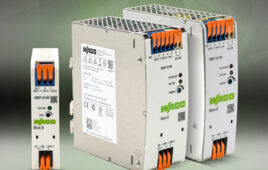
Tell Us What You Think!